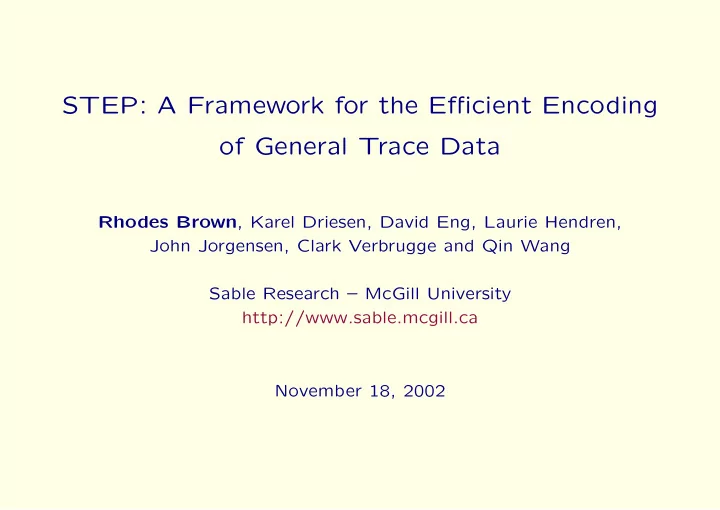

STEP: A Framework for the Efficient Encoding of General Trace Data Rhodes Brown , Karel Driesen, David Eng, Laurie Hendren, John Jorgensen, Clark Verbrugge and Qin Wang Sable Research – McGill University http://www.sable.mcgill.ca November 18, 2002
Outline • The problems with current tracing methods. • A solution: STEP – Framework overview – Example: JVMPI allocation data – Uses of STEP data
Problem #1 With Traces: Formats are too event-specific ...look at the Java run-time environment: • Virtual method dispatch • Garbage collection • Explicit concurrency ⇒ Need an openly extensible format
Problem #2 With Traces: They are very large • Generic compression methods are not good enough • Specialized schemes can lead to better compression • Often require tuning to specific data set ⇒ Need adjustable encoding strategies
The STEP System STEP: a framework for encoding a variety of trace events Main Features: • An event definition language & compiler to generate interface elements ⇒ flexibility, extensibility, & documentation • An encoding engine to implement various reduction schemes ⇒ encapsulation & compactness
The STEP Framework: Overview Data Object Definitions Event Producers Event Consumers stepc Program Modified JVM EVolve Encoding Strategies Data Objects Data Objects Program Decompress Compress JVMPI STEP STEP JIMPLEX trace file Encoder Decoder Program Trace Encoding Analysis Modified Tool Source
Example: Encoding JVMPI Data Benchmark: 213 javac • 6319542 allocation records • na ¨ ıve (verbatim) format: 150.67 MB • compressed ( .gz ): 23.18 MB → 15.38%
JVMPI Data Definitions ✗ ✔ JVMPI Event ✖ ✕ .env ❍ ❨ ❍ ✒ � ❍ � ❍ ❈ ❖ ❍ ❈ � ❍ ❍ ❈ � ❍ ❍ ❈ � ❍ ❍ ❈ � ❍ ❍ ❈ � ❍ ✬ ✩ ❍ ❈ � ✛ ✘ ❍ ✬ ✩ ❍ ❈ ❍ Allocation Free Method Enter .arena .objId .method ✚ ✙ .class .target ✫ ✪ .array .size .newObj ✫ ✪
STEP-DL for Allocation Events record OBJECT ALLOC extends JVMPI Event { int arenaId; int classId <property:"address"><encoding:"size=4">; int isArray <property:"unsigned">; int size <property:"unsigned">; int newObjId <property:"address"><encoding:"size=4">; }
STEP-DL for Allocation Events record OBJECT ALLOC extends JVMPI Event { int arenaId; int classId <property:"address"><encoding:"size=4">; int isArray <property:"unsigned">; int size <property:"unsigned">; int newObjId <property:"address"><encoding:"size=4">; } - Structure
STEP-DL for Allocation Events record OBJECT ALLOC extends JVMPI Event { int arenaId; int classId <property:"address"><encoding:"size=4">; int isArray <property:"unsigned">; int size <property:"unsigned">; int newObjId <property:"address"><encoding:"size=4">; } - Structure - Inheritance
STEP-DL for Allocation Events record OBJECT ALLOC extends JVMPI Event { int arenaId; int classId <property:"address"><encoding:"size=4">; int isArray <property:"unsigned">; int size <property:"unsigned">; int newObjId <property:"address"><encoding:"size=4">; } - Structure - Inheritance - Attributes
STEP-DL for Allocation Events record OBJECT ALLOC extends JVMPI Event { int arenaId; int classId <property:"address"><encoding:"size=4">; int isArray <property:"unsigned">; int size <property:"unsigned">; int newObjId <property:"address"><encoding:"size=4">; } - Structure - Inheritance - Attributes
Baseline Comparison raw size .step size ratio original 150.67 MB 102.51 MB 68.04% compressed 23.18 MB 18.21 MB 78.56% ratio 15.38% 17.76% 12.08%
Baseline Comparison raw size .step size ratio original 150.67 MB 102.51 MB 68.04% compressed 23.18 MB 18.21 MB 78.56% ratio 15.38% 17.76% 12.08% - Record size reduction
Baseline Comparison raw size .step size ratio original 150.67 MB 102.51 MB 68.04% compressed 23.18 MB 18.21 MB 78.56% ratio 15.38% 17.76% 12.08% - Record size reduction - Compression ratio
Baseline Comparison raw size .step size ratio original 150.67 MB 102.51 MB 68.04% compressed 23.18 MB 18.21 MB 78.56% ratio 15.38% 17.76% 12.08% - Record size reduction - Compression ratio - Overall reduction
Remove Constant Values record JVMPI Event { int envId <property:"address"><encoding:"size=4"> }
Remove Constant Values record JVMPI Event { int envId <property:"address"><encoding:"size=4"> <encoding:"repeat">; }
Remove Constant Values record JVMPI Event { int envId <property:"address"><encoding:"size=4"> <encoding:"repeat">; } raw size .step size ratio original 150.67 MB 78.41 MB 52.04% compressed 23.18 MB 17.35 MB 74.87% ratio 15.38% 22.13% 11.52%
The Identifier Technique record OBJECT ALLOC extends JVMPI Event { int arenaId; int classId <encoding:"identifier">; int isArray; int size; int newObjId; }
The Identifier Technique record OBJECT ALLOC extends JVMPI Event { int arenaId; int classId <encoding:"identifier">; int isArray; int size; int newObjId; }
The Identifier Technique record OBJECT ALLOC extends JVMPI Event { int arenaId; int classId <encoding:"identifier">; int isArray; int size; int newObjId; } raw size .step size ratio original 150.67 MB 63.58 MB 42.20% compressed 23.18 MB 17.24 MB 74.38% ratio 15.38% 27.11% 11.44%
The Difference Technique record OBJECT ALLOC extends JVMPI Event { int arenaId; int classId; int isArray; int size; int newObjId <encoding:"delta=1048576">; }
The Difference Technique record OBJECT ALLOC extends JVMPI Event { int arenaId; int classId; int isArray; int size; int newObjId <encoding:"delta=1048576">; }
The Difference Technique record OBJECT ALLOC extends JVMPI Event { int arenaId; int classId; int isArray; int size; int newObjId <encoding:"delta=1048576">; } raw size .step size ratio original 150.67 MB 46.01 MB 30.54% compressed 23.18 MB 1.97 MB 8.49% ratio 15.38% 4.28% 1.31%
Example Use I - EVolve
Example Use II - JIMPLEX
Future Directions • Pattern analysis – Extraction of “hot streams” • New reduction strategies • Integration with other tracing tools
Summary • The problems with current tracing methods. • A solution: STEP – Framework overview – Example: JVMPI allocation data – Uses of STEP data
Links to More Information STEP http://www.sable.mcgill.ca/step/ EVolve http://www.sable.mcgill.ca/evolve/ JIL (JIMPLEX) http://www.sable.mcgill.ca/jil/ Sable Research http://www.sable.mcgill.ca
Recommend
More recommend